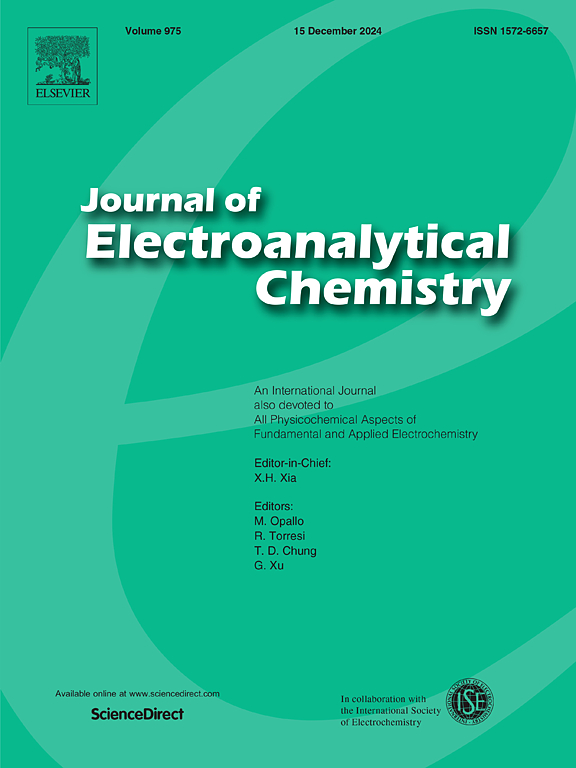酸蚀铁基普鲁士蓝衍生物作为高性能钠离子电池正极材料
IF 4.1
3区 化学
Q1 CHEMISTRY, ANALYTICAL
引用次数: 0
摘要
铁基普鲁士蓝(Fe-PB)材料由于其独特的开放式框架结构,作为钠离子电池正极材料得到了广泛的研究。然而,提高导电率和减少普鲁士蓝类似物的结构缺陷仍然具有挑战性。在本研究中,通过邻苯二甲酸(PA)辅助螯合和蚀刻工艺,成功合成了中心逐渐向内蚀刻的中空层状Fe-PB材料。与传统的水热合成材料相比,制备的Fe-PB具有比表面积增大、钠离子扩散路径缩短、晶格含水量降低等特点,从而显著提高了材料的电化学性能。当作为钠离子电池的正极材料时,蚀刻的Fe-PB在电流密度为100 mA g - 1时的初始比容量为106.4 mAh g - 1。500次充放电循环后,电池的比容量保持在78.8 mAh g−1,容量保持率为74.1%,每循环容量衰减率为0.05%。这项工作不仅为提高Fe-PB材料的钠储存性能提供了有效的策略,而且为水热合成具有降低晶格含水量和增强电化学性能的高性能普鲁士蓝类似物提供了有价值的见解。本文章由计算机程序翻译,如有差异,请以英文原文为准。
Acid-etched iron-based Prussian blue derivatives as high-performance cathode materials for sodium-ion batteries
Iron-based Prussian blue (Fe-PB) materials have been widely investigated as cathode materials for sodium-ion batteries owing to their unique open framework structure. However, the enhancement of electrical conductivity and the reduction of structural defects in Prussian blue analogues remain challenging. In this study, hollow layered Fe-PB materials with gradually inward-etched centers were successfully synthesized through a phthalic acid (PA)-assisted chelation and etching process. Compared to conventionally hydrothermally synthesized materials, the prepared Fe-PB was characterized by an increased specific surface area, shortened sodium-ion diffusion pathways, and reduced lattice water content, leading to significantly improved electrochemical properties. When evaluated as a cathode material for sodium-ion batteries, the etched Fe-PB demonstrated an initial specific capacity of 106.4 mAh g−1 at a current density of 100 mA g−1. After 500 charge/discharge cycles, a specific capacity of 78.8 mAh g−1 was maintained, corresponding to a capacity retention rate of 74.1 % and a remarkably low capacity decay rate of 0.05 % per cycle. This work not only provides an effective strategy for improving the sodium storage performance of Fe-PB materials but also offers valuable insights into the hydrothermal synthesis of high-performance Prussian blue analogues with reduced lattice water content and enhanced electrochemical properties.
求助全文
通过发布文献求助,成功后即可免费获取论文全文。
去求助
来源期刊
CiteScore
7.80
自引率
6.70%
发文量
912
审稿时长
2.4 months
期刊介绍:
The Journal of Electroanalytical Chemistry is the foremost international journal devoted to the interdisciplinary subject of electrochemistry in all its aspects, theoretical as well as applied.
Electrochemistry is a wide ranging area that is in a state of continuous evolution. Rather than compiling a long list of topics covered by the Journal, the editors would like to draw particular attention to the key issues of novelty, topicality and quality. Papers should present new and interesting electrochemical science in a way that is accessible to the reader. The presentation and discussion should be at a level that is consistent with the international status of the Journal. Reports describing the application of well-established techniques to problems that are essentially technical will not be accepted. Similarly, papers that report observations but fail to provide adequate interpretation will be rejected by the Editors. Papers dealing with technical electrochemistry should be submitted to other specialist journals unless the authors can show that their work provides substantially new insights into electrochemical processes.

 求助内容:
求助内容: 应助结果提醒方式:
应助结果提醒方式:


